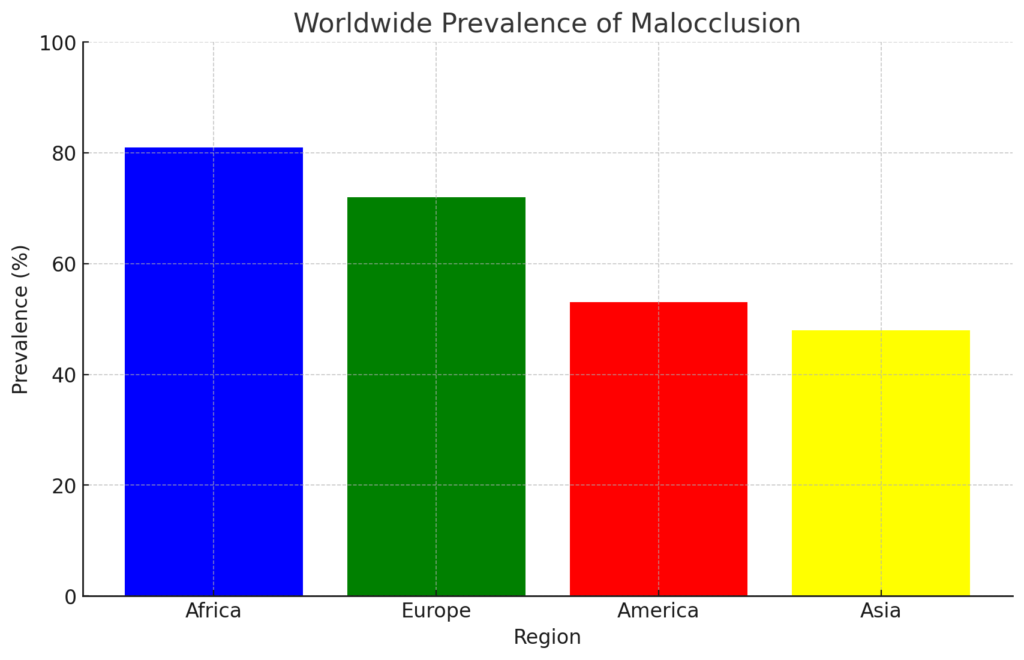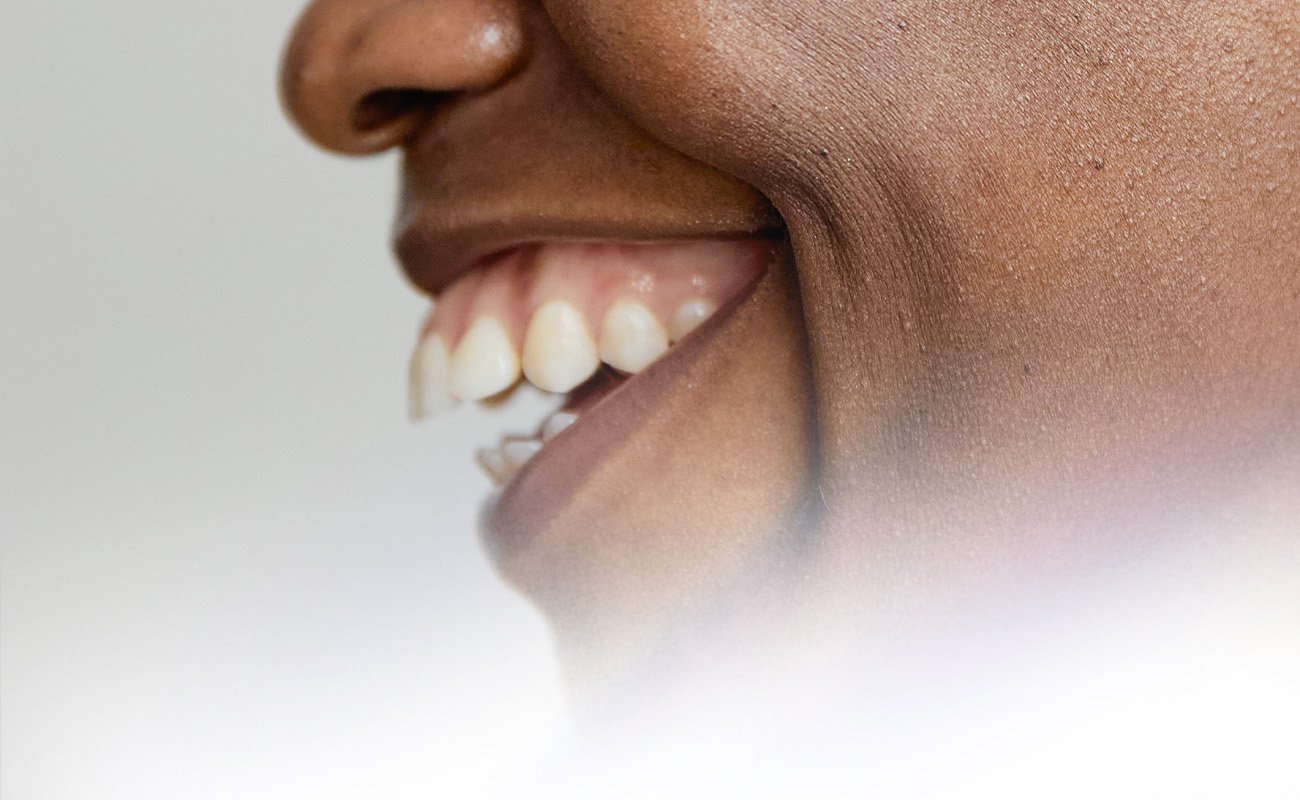Open bites can have serious consequences for oral health. In this article, we will discuss the causes of open bites, which can range from genetic factors to specific behaviors. We will also detail the potential problems that can arise if an open bite is not addressed, such as difficulty speaking and increased tooth wear. We’ll describe the different classifications of open bites and methods to prevent them. Additionally, we’ll discuss how to fix open bite naturally and present dental treatments available for correction.
Open Bite
An open bite is a type of malocclusion where the upper and lower teeth do not come together correctly when biting down. This misalignment of teeth can lead to several issues, such as difficulty chewing food, problems with speech, and increased wear on teeth.
Open bite is less common than overbites and underbites and often occurs during the transition from milk teeth to permanent teeth. In many cases, the problem corrects itself and does not persist into adulthood. However, in some individuals, the malocclusion persists and requires treatment.
While open bite may not necessarily worsen with age, leaving it untreated can have long-term consequences. An untreated open bite can lead to difficulties in speech, problems with chewing, and even uneven wear on teeth.

Causes of Open Bite
The causes of open bites can be multifaceted, including habits, genetics, and developmental factors. Recognizing the potential causes of an open bite can be an important step toward finding suitable natural solutions to address the issue. Let’s discuss some of the key factors that can contribute to the development of this type of malocclusion.
Pacifier-sucking habits: Open bites can primarily be caused by thumb or pacifier-sucking habits. Prolonged sucking on foreign objects might cause pressure on the teeth, leading to misalignment issues. As a result, the teeth’s growth patterns are disrupted, and the bite does not close as required.
Tongue thrusting: Another potential cause of open bites originates from tongue thrusting. This refers to when a person pushes their tongue against or between their teeth when swallowing or speaking. The persistent pressure exerted by the tongue creates an imbalance, causing the teeth to shift and creating an open bite.
Genetic predisposition: The third factor worth considering is genetic predisposition. Some individuals are more likely to develop dental malocclusions, including open bites, due to inherited traits. Genetic factors can influence the size and position of an individual’s teeth or jaw, contributing to bite misalignment.
Incorrect jaw growth: Lastly, incorrect jaw growth or facial bone development can also be responsible for causing an open bite. Incidents of trauma to the face, the presence of tumors, or developmental issues might lead to improper bone growth, resulting in an open bite.
See also: Fixing Overjet Issues With Braces and Other Orthodontics
Long-Term Impact and Potential Complications
An untreated open bite can lead to various challenges. In this section, we highlighted the long-term effects and potential complications associated with this dental misalignment.
Difficulty Chewing and Biting: An open bite can lead to difficulty in chewing and biting food, as the teeth cannot make proper contact. This issue can cause discomfort during meals and can also result in insufficient chewing, which may lead to digestive problems in the long run.
Speech Issues: Individuals with an open bite may face speech difficulties, such as problems with articulation and clarity. The inability of the teeth to connect properly can cause issues with certain sounds, especially those that involve the tongue against the upper teeth.
Dental Problems: Open bites can lead to various dental issues, such as uneven tooth wear, increased risk of tooth decay, and gum problems. Due to the improper contact of teeth, excessive force may be exerted on certain teeth, resulting in faster wear and potential damage to the surrounding gum tissue.
Problems with Breathing: An open bite can cause problems with breathing, particularly during sleep. The misaligned teeth may contribute to an obstructed airway, increasing the risk of sleep apnea, a condition characterized by repeated pauses in breathing during sleep.
Aesthetic Issues: Lastly, open bites can cause aesthetic concerns as they often result in an unbalanced facial appearance. This imbalance may negatively impact an individual’s self-esteem and confidence, which can have long-term psychological effects.
See also: Alternatives to Braces for Adults
Types of Open Bite
There are several types of open bite that can be categorized based on the affected area of the mouth and the underlying cause. In this section, we will be discussing four sub-types of open bite: Anterior open bite, Posterior open bite, Dental Open Bite, and Skeletal Open Bite.
Anterior Open Bite
Anterior open bite is the most common type of open bite, where the front teeth do not touch while the back teeth are in contact with each other. This can lead to problems with speech, bite functionality, and appearance. Some of the possible causes for an anterior open bite include thumb sucking, tongue thrusting, or genetics. Treatment options may vary depending on the severity of the condition and the patient’s age, with orthodontic treatments like braces and Invisalign being viable solutions in many cases.
Posterior Open Bite
Posterior open bite refers to a situation where the back teeth do not make contact, but the front teeth fit together normally. This type of open bite is less common and can lead to chewing difficulties or accelerated tooth wear. Reasons for posterior open bite can be skeletal or dental irregularities, and treatment methods may include orthodontic solutions or oral surgery, depending on the underlying cause.
Dental Open Bite
A dental open bite is primarily caused by an issue with the teeth themselves, such as misaligned teeth or uneven tooth wear. It can often be corrected through dental treatments like braces, Invisalign, or dental bonding, which focus on repositioning and restructuring the teeth to fit together properly.
Skeletal Open Bite
Skeletal open bite, on the other hand, occurs due to an imbalance in the shape, size, or position of the jawbones. This type of open bite often requires more complex interventions, such as orthognathic surgery (also known as jaw surgery), to correct the underlying skeletal issue. In some cases, orthodontic treatments like braces may be used in conjunction with surgery to achieve the desired outcome.

Prevention Methods
Prevention is better than cure. After understanding the causes, effects, and types of open bite, we’ll now focus on prevention strategies for this dental misalignment.
Healthy Chewing Habits
Developing healthy chewing habits is essential for preventing open bites. Encourage children to chew with their back teeth, rather than their front teeth, or move their jaw from side to side. This helps promote proper alignment of the teeth and jaw. Ensure they chew their food slowly and evenly on both sides, which can aid in maintaining a healthy bite.
Avoid Thumb Sucking
Thumb sucking is a common habit in young children, but if it persists for too long, it could lead to an open bite. Encourage kids to stop thumb-sucking by offering praise when they avoid the habit and providing alternative activities, such as fidget toys, to keep their hands busy.
Use of Orthodontic Devices
Orthodontic devices, such as braces or Invisalign, can help prevent open bites by ensuring proper alignment of the teeth. In some cases, early intervention using a device like a palate expander can help prevent open bites from developing altogether.
How to Fix Open Bite Naturally
Now let’s explore potential natural remedies to address this dental issue:
Tongue Exercises
Tongue exercises can play an important role in fixing an open bite naturally. One popular exercise is mewing, which involves pressing the tongue against the roof of the mouth, ensuring correct tongue posture and promoting proper jaw growth. Practice mewing daily to strengthen the tongue and encourage better bite alignment.
Jaw Exercises
In addition to tongue exercises, jaw exercises can improve the strength and functionality of jaw muscles. For example, try practicing the chin tuck: gently pull the lower jaw back, align it with the upper jaw, and then release it. Repeat this exercise 10-15 times a day. Another useful exercise is the jaw opening and closing exercise, where you open your mouth as wide as possible without causing discomfort, and then slowly close it. Perform this exercise for 10 repetitions, twice a day.
Mouthguard Use
Using a mouthguard can be an effective way to correct an open bite naturally by applying gentle pressure to the teeth and jaw. Over time, this continuous pressure may help shift the teeth into proper alignment.
Dental Treatment
If natural remedies aren’t effective or immediate results are needed, let’s explore dental treatment options.
Braces
Braces are a common and effective treatment for open bite, where brackets and wires are placed on the teeth to gradually move them into the correct position. The pressure from the braces helps to align the teeth and alleviate the open bite, resulting in a more balanced and functional bite pattern. This method can take several months to years, depending on the severity of the open bite.
Invisalign and Clear Aligners
An alternative to braces, Invisalign, and clear aligners function similarly by applying gentle pressure to the teeth to gradually correct the open bite. These removable aligners are custom-made and replaced every few weeks to account for the tooth movement. They are discreet and generally more comfortable than conventional braces, making them an attractive option for many patients.
If you are looking for an affordable and efficient teeth straightening solution then invisible braces are a great choice. Here is a selection of companies to help you with your selection.

Byte
An affordable option with refundable impression kits, free HyperByte, and a Byte for Life guarantee.
Check out Byte Aligners
Candid
A hybrid of in-office and at-home treatment that provides 1-on-1 orthodontist support.
Check out Candid AlignersTongue Spurs
For open bites caused by tongue thrusting, tongue spurs can be effective in controlling this habit. These small appliances are placed on the roof of the mouth, creating an uncomfortable sensation when the patient presses their tongue against it. The spurs help to retrain the tongue posture and prevent it from interfering with the teeth, allowing the open bite to be corrected naturally or in conjunction with orthodontic treatment.
Surgery in Severe Cases
In severe cases of open bite, surgery may be necessary to move the jawbones into proper alignment and achieve optimal results. This is generally done as a last resort when nonsurgical methods have not yielded satisfactory outcomes. Surgery may involve the repositioning of the jaw or even the addition of bone grafts to achieve the desired correction.
By using these treatments, individuals with open bites can achieve proper dental alignment and improve their oral health. Each method offers its advantages, and patients should consult with their orthodontist to determine the best approach for their specific case.
Frequently Asked Questions
What are some natural methods to correct open bite?
There are several natural methods to correct an open bite, including mewing, which involves proper tongue posture during rest and swallowing. Orthotropic appliances like the palate expander can also help improve dental arch development. In addition, maintaining proper oral habits such as avoiding thumb sucking or tongue thrusting can prevent further worsening of an open bite.
Can open bite self-correct over time?
In some cases, particularly among young children, an open bite may self-correct as they grow and develop. However, this is not guaranteed for every individual. In most cases, especially in adults, an open bite will require intervention through orthodontic treatment or surgical procedures to achieve proper alignment.
How effective is mewing in treating open bites?
Mewing, a technique that promotes proper tongue posture, may help improve open bites to some extent. However, the effectiveness of mewing in treating open bites may vary depending on the individual and the severity of the condition. It is advisable to consult an orthodontist or dental professional to determine if mewing can be beneficial in your specific case.
What are the alternatives to surgery for open bite treatment?
Orthodontic treatment, such as braces or Invisalign, can often be used as an alternative to surgery for open bite treatment. Additionally, other oral appliances like the palate expander can help improve dental arch development without surgery. However, the effectiveness of these alternative treatments depends on the severity of the open bite and the individual’s unique situation.
How can braces help in fixing an open bite?
Braces work by applying constant pressure on the teeth, gradually moving them into proper alignment. The use of braces can correct mild to moderate open bites by repositioning the teeth and improving the occlusion. In some severe cases, braces may be used in conjunction with surgical intervention to achieve optimal results.
What are the consequences of not treating an open bite?
Not treating an open bite can lead to various dental issues, such as difficulty in chewing, speech problems, and increased wear on the properly aligned teeth. Untreated open bites may also result in a higher risk of tooth decay, gum disease, and temporomandibular joint disorders (TMD).
Sources
Lombardo, G., Vena, F., Negri, P., Pagano, S., Barilotti, C., Paglia, L., Colombo, S., Orso, M., Cianetti, S., Worldwide prevalence of malocclusion in the different stages of dentition: A systematic review and meta-analysis. Eur J Paediatr Dent. 2020 Jun;21(2):115-122. DOI: 10.23804/ejpd.2020.21.02.05. Available online at: https://pubmed.ncbi.nlm.nih.gov/32567942/
Cenzato, N., Nobili, A., Maspero, C., Prevalence of Dental Malocclusions in Different Geographical Areas: Scoping Review. Dent J (Basel). 2021 Oct; 9(10): 117. DOI: 10.3390/dj9100117. Available online at: https://www.ncbi.nlm.nih.gov/pmc/articles/PMC8534899/
Jaber, S. T., Hajeer, M. Y., Sultan, K., Treatment Effectiveness of Clear Aligners in Correcting Complicated and Severe Malocclusion Cases Compared to Fixed Orthodontic Appliances: A Systematic Review, Cureus. 2023 Apr; 15(4): e38311. DOI: 10.7759/cureus.38311. Available online at: https://www.ncbi.nlm.nih.gov/pmc/articles/PMC10148732/
Pisani, L., Bonaccorso, L., Fastuca, R., Spena, R., Lombardo, L., Caprioglio, A., Systematic review for orthodontic and orthopedic treatments for anterior open bite in the mixed dentition. Prog Orthod. 2016; 17: 28. DOI: 10.1186/s40510-016-0142-0. Available online at: https://www.ncbi.nlm.nih.gov/pmc/articles/PMC5027197/
Lone, I. M., Zohud, O., Midlej, K., Paddenberg, E., Krohn, S., Kirschneck, C., Proff, P., Watted, N., Iraqi, F. A., Anterior Open Bite Malocclusion: From Clinical Treatment Strategies towards the Dissection of the Genetic Bases of the Disease Using Human and Collaborative Cross Mice Cohorts. J Pers Med. 2023 Nov; 13(11): 1617. DOI: 10.3390/jpm13111617. Available online at: https://www.ncbi.nlm.nih.gov/pmc/articles/PMC10672619/

